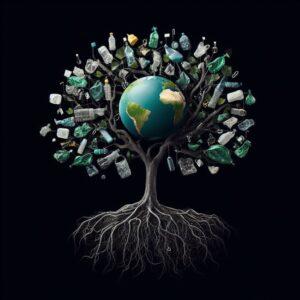Depletion
Resource Depletion

The production of electronic devices, such as smartphones and computers, requires the extraction of rare and valuable metals like lithium, cobalt, and rare earth elements. Mining and extracting these resources can lead to habitat destruction, soil and water contamination, and ecosystem disruption.
Energy
Energy Consumption

Many technological devices and systems consume significant amounts of energy, especially data centers, which support cloud computing and digital services. The energy required for data storage, transmission, and processing contributes to greenhouse gas emissions, particularly when fossil fuels are used for power generation.
E-waste
E-Waste

The rapid turnover of electronic devices and the constant development of new technology lead to a growing problem of electronic waste (e-waste) . E-waste contains hazardous materials like lead, mercury, and cadmium, which can leach into the soil and water if not properly managed.
Beyond e-waste, the production of technology also generates other forms of waste, such as packaging materials, which can contribute to landfill and pollution problems.
Recycling and disposal of e-waste are often inadequate, leading to environmental pollution.
Deforestation
Deforestation

The demand for paper and wood products has increased due to technological advancements, leading to deforestation in many parts of the world. Additionally, the expansion of infrastructure and urban development often involves cutting down trees and clearing land.
Pollution
Pollution

Industrial processes required for manufacturing technology components, as well as the disposal of electronic waste, can release pollutants into the air and water. This pollution can harm local ecosystems and affect human health.
Habit Loss
Loss of Biodiversity & Habitat

Technological development can disrupt natural habitats, leading to the displacement or extinction of species. Infrastructure development, such as roads and buildings, can fragment ecosystems, making it difficult for species to migrate and find food or mates.
Climate
Climate Change

The production and use of technology contribute to greenhouse gas emissions, which are a major driver of climate change. The energy-intensive processes involved in manufacturing and powering technology, as well as transportation emissions associated with the global supply chain, all play a role in this impact.
lifestyle
Sedentary Lifestyle

The use of technology, particularly screen-based activities like gaming and excessive screen time, can contribute to a sedentary lifestyle. This sedentary behavior is linked to various health problems, including obesity, cardiovascular disease, and musculoskeletal issues.
Mental Health
Mental Health

Excessive use of social media and digital devices has been associated with mental health issues such as anxiety, depression, and social isolation. Cyberbullying and online harassment are additional concerns.